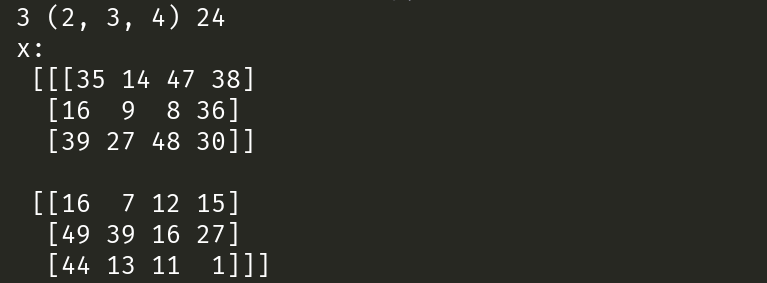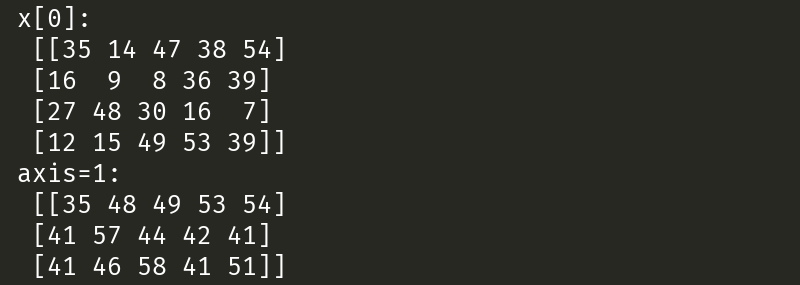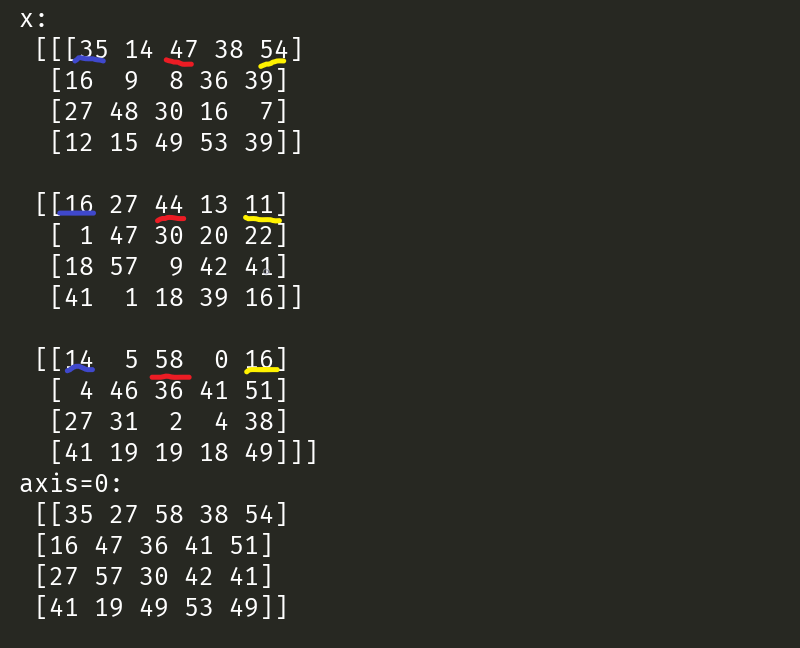原文:https://www.cnblogs.com/ppes/p/9461246.html 一、官網的定義: https://docs.scipy.org/doc/numpy/user/quickstart.html In NumPy dimensions are called axes. For ...
原文:https://www.cnblogs.com/ppes/p/9461246.html
一、官網的定義:
https://docs.scipy.org/doc/numpy/user/quickstart.html
In NumPy dimensions are called axes.
For example, the coordinates of a point in 3D space [1, 2, 1] has one axis. That axis has 3 elements in it, so we say it has a length of 3. In the example pictured below, the array has 2 axes. The first axis has a length of 2, the second axis has a length of 3.
[[ 1., 0., 0.],
[ 0., 1., 2.]]
其實,可以這麼理解。維度(dimension) D和數組A,D[axis]和A[i] 。是不是大概懂了,axis對應第幾維度,與數組的下標的作用差不多。但是axis有點區別的。既然axis是下標那麼就有範圍:
[-維度,維度),如上例子axis的取值範圍 [-2,2),記住不包括2。
維度與axis的對應關係:axis是從最外層的 [] 數起來的,如上的例子,axis=0:第二維,axis=1:第一維。
二、驗證:
1 # 產生24個[0,50)的隨機整數,維度為3 2 x = np.random.RandomState(5).randint(50, size=[2, 3, 4]) 3 print(x.ndim, x.shape, x.size) 4 print("x:\n", x)

選一個能夠使用到axis的函數:這裡選用numpy.amax()(選出最大的元素),https://docs.scipy.org/doc/numpy/reference/generated/numpy.amax.html#numpy.amax
為了方便理解,先從最內層開始
1 print("x[0][0]:\n", x[0][0]) 2 print("axis=2: \n", np.amax(x, 2))

print("x[0]:\n", x[0]) print("axis=1: \n", np.amax(x, 1))

1 print("x:\n", x) 2 print("axis=0: \n", np.amax(x, 0))

很顯然,從axis=2,axis=1都挺好理解,但是axis=0就有點困惑了,而且這個僅僅是三維而已,那麼四維、五維呢。
但是其實仔細觀察axis=2的第一個數字54是怎麼來的呢?是從x[0][0][0]—x[0][0][4]比較而得。因此一共有3*4個。
同理axis=1時,比較的就是:x[0][0][0]—x[0][3][0],共3*5個
同理axis=2時,比較的是:x[0][0][0]—x[2][0][0],共4*5個
現在,是不是就對不同的axis的輸出的形狀或者說排列有一定的瞭解了?而且是不是體會到axis的作用了?我可是煩死那麼多方括弧了!!
三、總結
最直觀的:函數所選的axis的值,就表明 x[][][] 的第幾個方塊號,從0開始,代表第一個[ ],即x[ ] [ ] [ ]
不足或者錯誤之處,歡迎指正!

1 import numpy as np 2 3 # 產生60個[0,60)的隨機整數,維度為3 4 x = np.random.RandomState(5).randint(60, size=[3, 4, 5]) 5 print(x.ndim, x.shape, x.size) 6 print("x:\n", x) 7 print("x[0][0]:\n", x[0][0]) 8 print("axis=2: \n", np.amax(x, 2)) 9 10 print("x[0]:\n", x[0]) 11 print("axis=1: \n", np.amax(x, 1)) 12 13 print("x:\n", x) 14 print("axis=0: \n", np.amax(x, 0)) 15 print("\n", np.amin(x, 0)) 16 for i in range(4): 17 print(x[0][i][1])全部代碼




